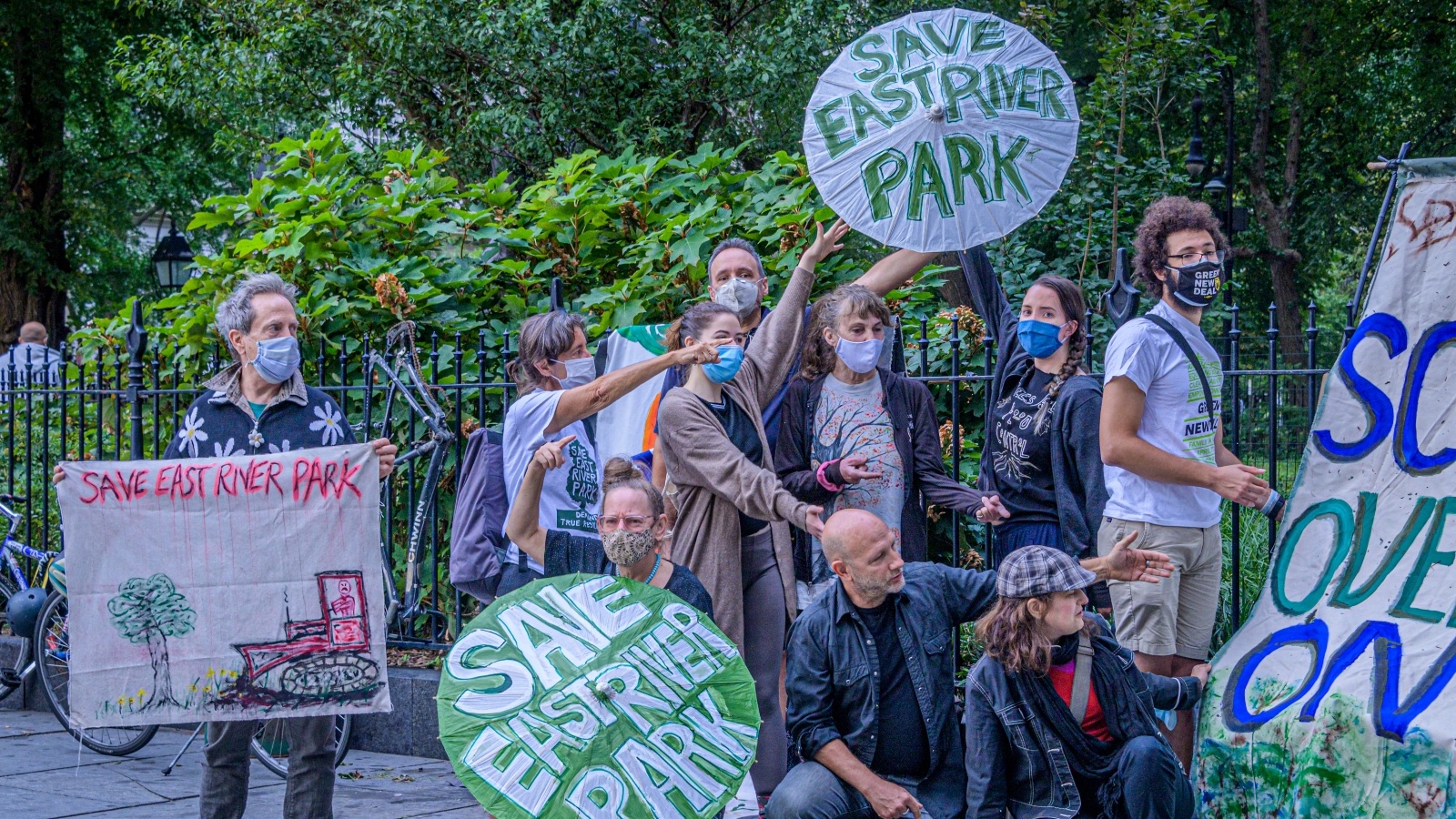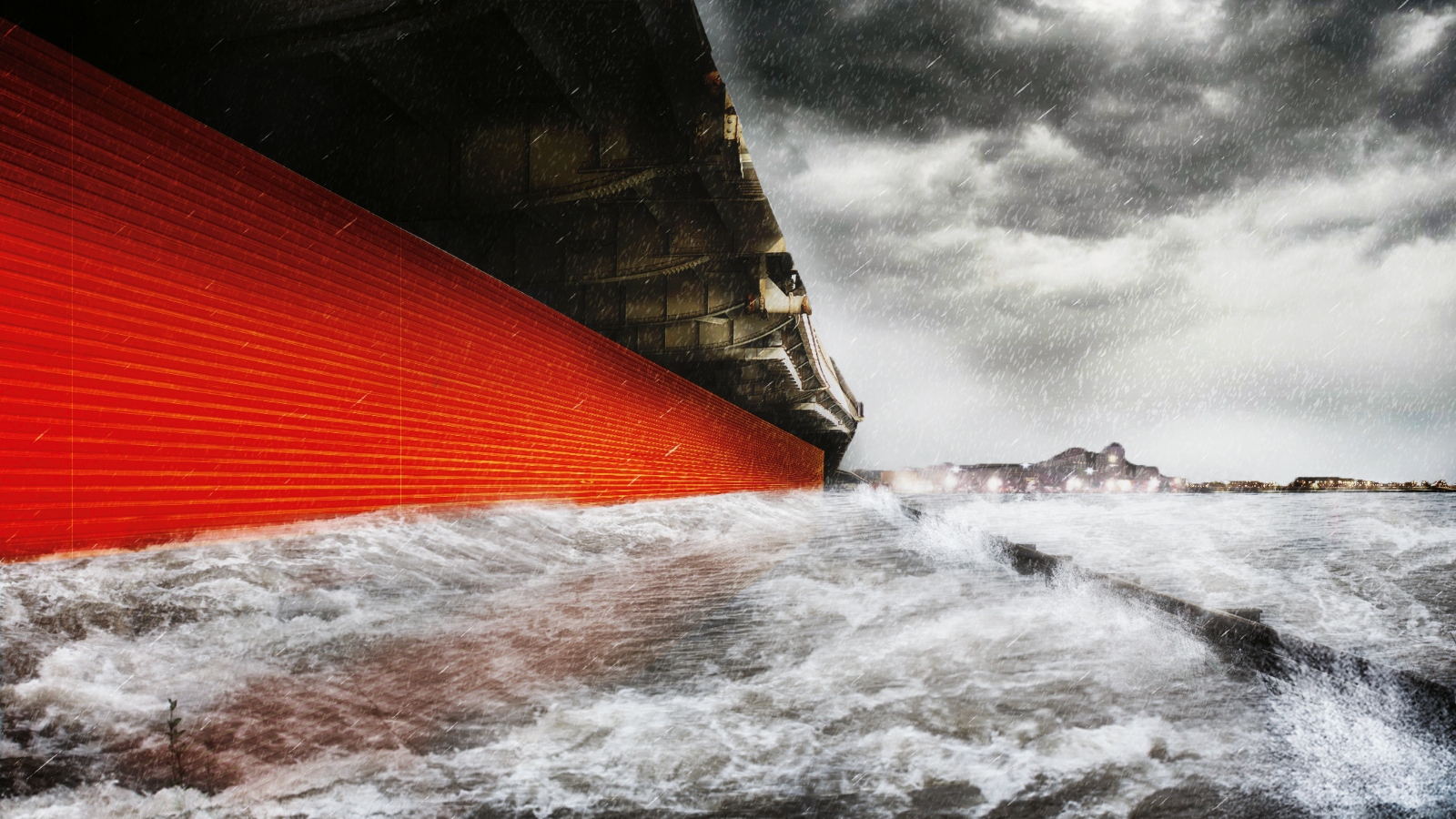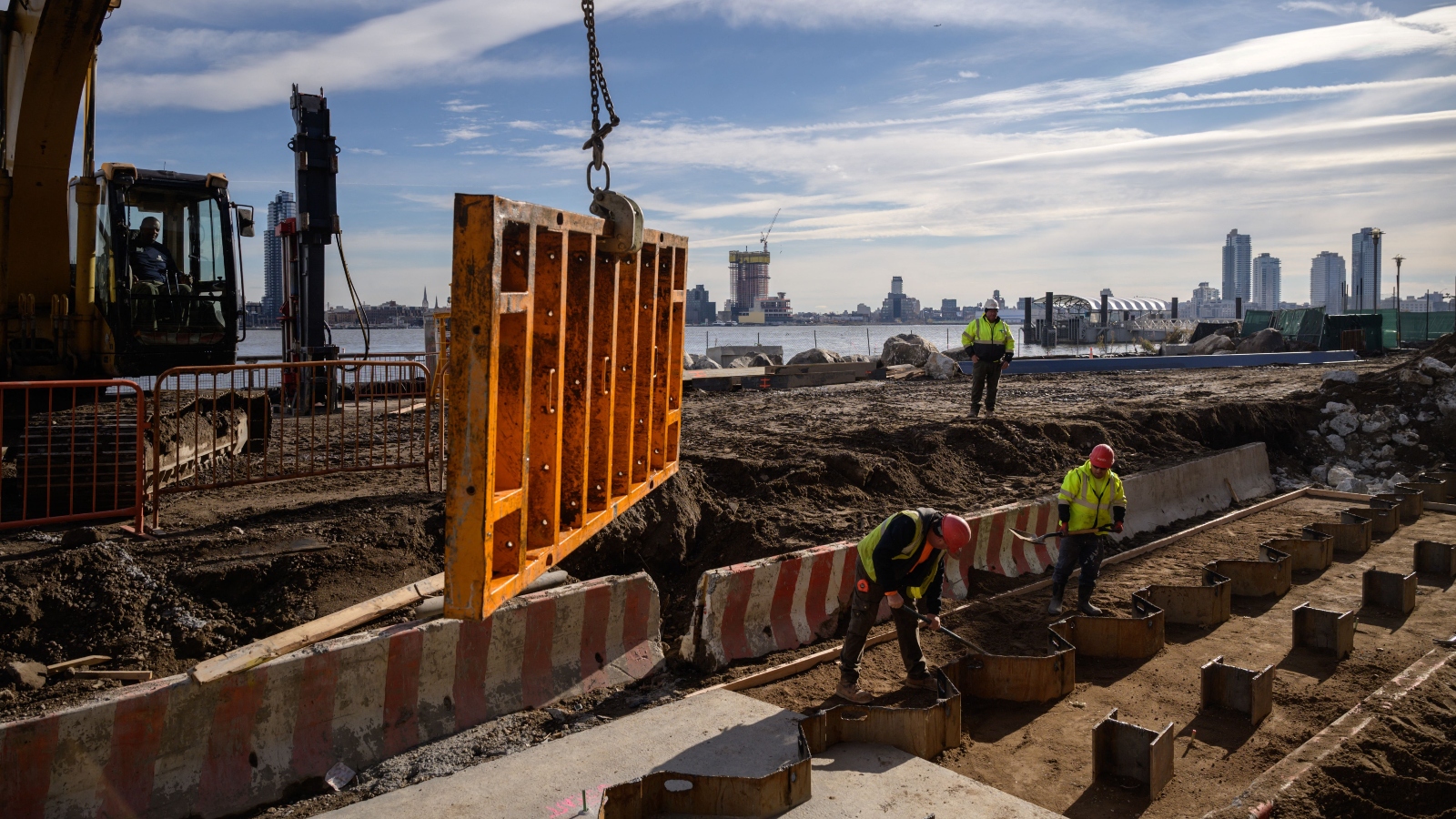When Superstorm Sandy made landfall on October 29, 2012, it pushed 13 feet of storm surge into New York City’s harbor, sweeping across the Brooklyn and Queens waterfronts and wiping entire neighborhoods off the map in Staten Island. Flooding knocked out power in Lower Manhattan, plunging downtown into near-total darkness as water rushed through the streets. The storm caused $19 billion in damages in the city alone, and it was clear that future storms could be even worse unless something changed.
Less than a year later, the Obama administration unveiled a massive federal initiative to ensure that the city not only recovered from Sandy, but built back better. The initiative, dubbed Rebuild by Design, promised to funnel money toward long-term climate adaptation measures in the hardest-hit areas, supplementing the usual barrage of disaster aid with money earmarked for forward-looking projects.
To say that officials aimed high would be an understatement. The Department of Housing and Urban Development, or HUD, which managed the initiative, threw its weight behind an idea called the “Big U.” The plan, drafted by the firm of Danish celebrity architect Bjarke Ingels, proposed to wrap the island of Manhattan, the financial and cultural capital of the United States, in miles of berms and artificial shorelines, creating a huge grassy shield that would both increase urban green space and defend the city from storm surge. The feds doled out an eye-popping $335 million for the first phase of the project, which soon captured the public’s imagination, in part thanks to iconic renderings from Bjarke Ingels Group (BIG) that showed a green paradise enfolding Manhattan. Ingels referred to it as “the love-child of Robert Moses and Jane Jacobs.”
If you stand in Battery Park on the southern tip of Manhattan today, 10 years after Sandy, it might be hard to imagine that the city is about to make the Big U vision a reality. Look a little closer, though, and there are signs of progress. Multiple pieces of the borough’s flood barrier have broken ground in the past year, and almost all the money for the system has been secured, with only a few pieces left to fund. After years of planning, design, and debate, the physical structure is starting to take shape.
“Once you start to see it in real life, it feels totally different,” said Amy Chester, the managing director of Rebuild by Design, which has gone on to help other cities plan resilience projects. “I worked in city government forever, and I didn’t expect all these projects to happen, but it happened.”

The Big U was a test case for large-scale climate adaptation. It wagered that cities could use a disaster like Sandy as a moment to rethink their relationship with nature, rather than just rebuild what had existed before.
In some ways, the bet paid off. The Big U project did manage to secure funding, and it is now being built, albeit years behind schedule and in modified form. After almost a decade of design work and public engagement, the city has proven that unconventional adaptation projects can work, and that cities can look beyond traditional flood walls and levees.
In another sense, though, the Big U is a reality check for these big projects. The project was kickstarted thanks to a rush of post-disaster money from a presidential administration that prioritized adaptation, but it couldn’t have gotten to this point without New York City’s unparalleled local resources. As Chester puts it, New York is a “different financial animal” than the rest of the country. Whereas other jurisdictions rely heavily on the federal government to fund big infrastructure projects, the city can also command huge amounts of municipal and state funding, which helps open the door for more ambitious and forward-looking projects. Absent a revamp of how the federal government funds climate adaptation, such projects will continue to remain out of reach for most cities.
“There are so many communities across the coastline including other major cities like Houston, Los Angeles, Seattle, Boston, Miami, Tampa,” said Linda Shi, an assistant professor of city planning at Cornell University who studies climate adaptation. “Are they going to see such sums of money? And then what about much smaller municipalities? They for sure are not going to see such levels of investment. That’s a real challenge, to think about how our infrastructure spending is going to meet that gap.”
The first task in the Big U project was to break Ingels’s dramatic vision into achievable chunks.
The $335 million that the city received from HUD went to fund a huge segment along the east side of Manhattan, one of the city’s hardest hit areas by the storm. For centuries, this part of the island consisted mostly of wetlands, before developers filled it in to make room for dense residential neighborhoods and public housing developments. When Sandy hit New York, its storm surge sought out these historical low-lying stretches, but the tidal channels and mudflats that had once absorbed excess water were long gone, replaced by concrete buildings and streets.
Ingels’s initial plan for the east side called for a massive tiered berm that would slope up from the water at East River Park, but this vision soon hit a roadblock: Officials in Mayor Bill de Blasio’s administration determined that building the berm would be too disruptive for a nearby highway — the busy FDR Drive — and a subsurface power line owned by the utility ConEd. Instead they decided to elevate the whole park on eight feet of artificial fill. But the city made a few serious missteps in communicating with locals about the new plan, and a coalition of locals, artists, and activists soon banded together to oppose it, arguing that it would remove trees and reduce access to a valuable community space.
Despite the public relations nightmare, the city began construction work on the east side project in earnest late last year, and has since ripped up about half the park. Dozens of trucks, cranes, and backhoes now fill the site, laying the groundwork for the fill that will raise it off the ground. The city now expects the project to be complete in 2026.

There’s a similar project in the works on the opposite shore of Manhattan, in an area called Battery Park City. Built in the 1970s on artificial land that extends out into the Hudson River, the neighborhood is governed by a state authority that can issue its own bonds, allowing local leaders to fund an $800 million resilience scheme to construct another segment of the Big U. As in East River Park, the plan here is to create a tiered series of elevated lawns that will stop coastal flooding from pushing inland.
But just like across town, this plan is not going over well with some locals, who have objected to the fact that it will close the park for multiple years. Earlier this summer, the campaigners attracted the attention of Republican gubernatorial candidate Lee Zeldin, who urged the state to pause construction until local concerns are heard.
“Residents have pointed out that Wagner Park didn’t experience severe flooding during Superstorm Sandy,” said Zeldin in a statement to the press. “Others have raised concerns about the exorbitant cost.” A group of locals is pushing an alternative design for the park, but crews are still expected to begin construction in the coming weeks.
The third and most difficult segment of the waterfront to protect is the two-mile stretch between these two other projects: the southern edge of Manhattan, stretching from lower Battery Park City past Wall Street and up toward the East Side. This stretch of shoreline is home to the towering skyscrapers of the Financial District, the offramps of the Brooklyn and Manhattan bridges, the packed historic neighborhood around the South Street Seaport, and another dense cluster of high-rise housing developments, not to mention a thicket of critical transportation infrastructure, including the elevated FDR Drive expressway and a subterranean car tunnel to Brooklyn.
Because the area is so overbuilt, with only a few dozen feet of free space between the water’s edge and the nearest street or building, the city doesn’t have the room to build big flood walls or berms like the ones it’s constructing in East River Park. Much of the waterfront territory in the neighborhood sits on concrete piles, which means it likely couldn’t support the two-story structure needed to protect the low-lying Financial District from a big storm event; the dense network of underground transportation and power infrastructure only further complicates such an effort. Plus, many of the buildings in the Seaport district are designated historic landmarks, making it even harder to build something new in their midst.
Faced with all these challenges, designers had to get creative. In one part of the problem area, near the dense Two Bridges neighborhood, the city chose a novel technological solution from the original Big U plan: a $500 million array of deployable flood walls that can flip up out of the ground during storm surge events, creating a temporary water barrier. Mayor Eric Adams broke ground on that project this week, and it is also expected to finish in 2026. Further down the shore, the city hopes to extend an artificial shoreline out into the water, creating a two-tiered berm with one segment that soars fifteen feet into the air and another that sweeps down toward the river.

Finding the funds for this last piece may be tricky. Much of the money for the flip-up flood walls arrived six years ago thanks to another Obama-era grant program that funded novel resilience strategies, but the berm around the Seaport will cost around $3.6 billion, according to the city’s latest estimates, and will take more than a decade to complete. Unless the city is hit by another Sandy, there likely won’t be another huge pile of post-disaster federal money for this project, which raises questions about how the city will pay for it. A recent federal grant to help support the project provided only $50 million, at most 1 percent of the total cost of the project.
Victor Papa, the president of the Two Bridges Neighborhood Council, which represents residents in the area, said he’s optimistic the project will come to fruition, and said he wasn’t disturbed by the long timeline.
“We’re feeling very confident,” he told Grist. “I am of the mind that when a project affects thousands of people, in thousands of housing units, that is not an overnight process, that’s a process that’s going to have a learning curve. I think the city did a good job in their design and their implementation.”
Even with most of the funding locked down, the trajectory for finishing the Big U is difficult to predict. The construction timeline for the rest of the project stretches to the end of the decade and beyond, and that’s assuming everything goes well. Future mayors may have to contend with controversy over construction impacts and cost overruns. The long timeline may also jeopardize the effectiveness of the project: the flip-up flood gates, for instance, only provide protection against the sea-level rise that will occur by 2050, which could make them inadequate as little as two decades after they are completed. There’s also the risk that another Sandy could strike while the city is still building the Big U, setting the timeline back even further.
“I think some of the estimates on time that the city put out right after Sandy were the absolute best-case scenario, and not everything turned out to be best case,” said Daniel Zarrilli, a special advisor on climate and sustainability at Columbia University who served as a climate policy advisor to Mayors Michael Bloomberg and de Blasio. “These are big, billion-dollar infrastructure projects and things do tend to take time, which is unfortunate, because time is not on our side.”

The current framework is also notable for what it leaves out — the city’s ambitions for the Big U are smaller than the original proposal from the Rebuild by Design days. The original berm structure conceived by Ingels would have extended from 42nd Street on the East Side all the way around the island and up the West Side to 57th Street, but the city has lopped off sections on both sides. Rather than push the project up the sides of the island, the city scaled back its ambitions to the barrier segment it knew it could afford.
The responsibility for protecting the rest of Manhattan and New York City now lies with the U.S Army Corps of Engineers, the nation’s chief builder of flood projects. In most other cities, the Corps might have taken charge of storm surge adaptation from the beginning, drafting an infrastructure project and securing money for it from Congress, but that wasn’t the case in New York. The pot of money the city received from HUD allowed it to pursue the nontraditional vision of the Big U, and leaders later rejected the Corps’ controversial proposal to create a five-mile storm gate across New York Harbor.
Now, though, the Corps has returned to fill in the gaps: The agency this month unveiled a $52 billion plan to build a series of storm gate structures across the city and in New Jersey as well. One structure would extend deployable flood gates up the West Side of Manhattan, approximating the extent of Ingels’s original scheme. If executed well, the Corps plan would also help bolster flood resilience in vulnerable parts of the city that didn’t receive the same jackpot of HUD money that Lower Manhattan did. There were other ambitious Rebuild by Design ventures for some of these places too, including the Bronx and Staten Island, but none so ambitious as the Big U. On its own, a flood barrier around Lower Manhattan wouldn’t help those areas, and might even push more water toward them during storm surge events.
“There’s only so much money that the city had, and the federal funding streams allowed us to do some work, but not all of it,” said Zarrilli. For the rest of it, he said, “we need the Army Corps.”
Even this some-but-not-all achievement would be difficult to replicate in other cities that don’t have New York’s local resources or a pot of recovery money from a friendly presidential administration. Bond measures and federal resilience grants can help fund smaller-scale adaptation projects, but transformative green infrastructure on the scale achieved in Manhattan will likely remain out of reach elsewhere in the United States.
Furthermore, Shi, from Cornell, cautions that new infrastructure can’t be the only way we adapt to climate change. The Big U may be an admirable example of how cities can rebuild for rising seas, but it won’t work unless accompanied by other measures that shift development away from flood zones and help people relocate from the riskiest places.
“I think there is a certain kind of danger to the siren song that the Big U sings for us, because it is so visually appealing that we might think that it is going to solve the problem on its own,” she said. “But that’s just one kind of innovation. And that same kind of imagination needs to be there in those … non-design spaces in order for all of this to actually pencil out.”




